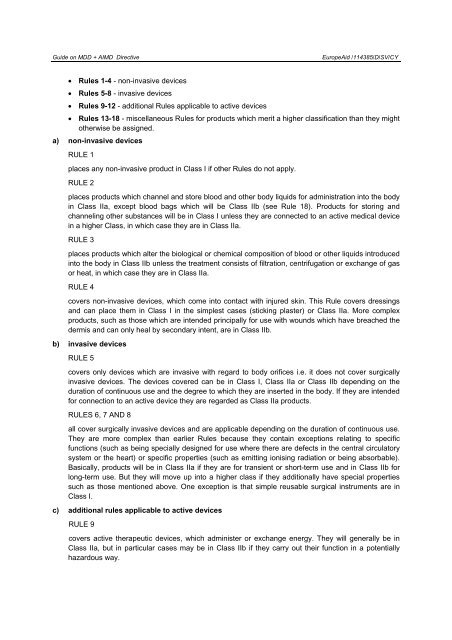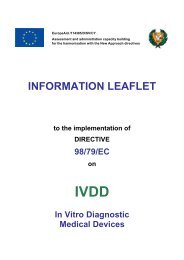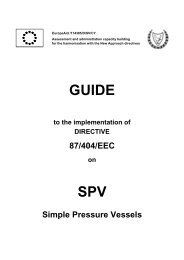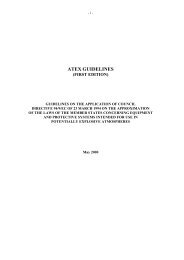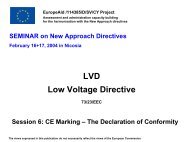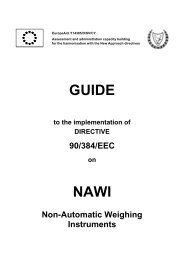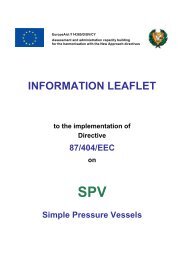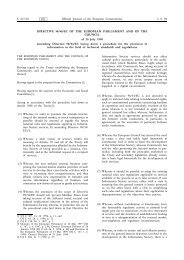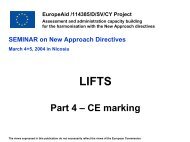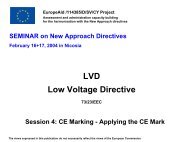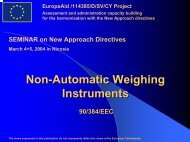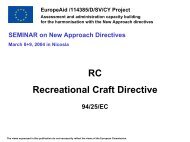GUIDE AIMD MDD - Cyprus Organization for the Promotion of Quality
GUIDE AIMD MDD - Cyprus Organization for the Promotion of Quality
GUIDE AIMD MDD - Cyprus Organization for the Promotion of Quality
You also want an ePaper? Increase the reach of your titles
YUMPU automatically turns print PDFs into web optimized ePapers that Google loves.
Guide on <strong>MDD</strong> + <strong>AIMD</strong> DirectiveEuropeAid /114385/D/SV/CY• Rules 1-4 - non-invasive devices• Rules 5-8 - invasive devices• Rules 9-12 - additional Rules applicable to active devices• Rules 13-18 - miscellaneous Rules <strong>for</strong> products which merit a higher classification than <strong>the</strong>y mighto<strong>the</strong>rwise be assigned.a) non-invasive devicesRULE 1places any non-invasive product in Class I if o<strong>the</strong>r Rules do not apply.RULE 2places products which channel and store blood and o<strong>the</strong>r body liquids <strong>for</strong> administration into <strong>the</strong> bodyin Class IIa, except blood bags which will be Class IIb (see Rule 18). Products <strong>for</strong> storing andchanneling o<strong>the</strong>r substances will be in Class I unless <strong>the</strong>y are connected to an active medical devicein a higher Class, in which case <strong>the</strong>y are in Class IIa.RULE 3places products which alter <strong>the</strong> biological or chemical composition <strong>of</strong> blood or o<strong>the</strong>r liquids introducedinto <strong>the</strong> body in Class IIb unless <strong>the</strong> treatment consists <strong>of</strong> filtration, centrifugation or exchange <strong>of</strong> gasor heat, in which case <strong>the</strong>y are in Class IIa.RULE 4covers non-invasive devices, which come into contact with injured skin. This Rule covers dressingsand can place <strong>the</strong>m in Class I in <strong>the</strong> simplest cases (sticking plaster) or Class IIa. More complexproducts, such as those which are intended principally <strong>for</strong> use with wounds which have breached <strong>the</strong>dermis and can only heal by secondary intent, are in Class IIb.b) invasive devicesRULE 5covers only devices which are invasive with regard to body orifices i.e. it does not cover surgicallyinvasive devices. The devices covered can be in Class I, Class IIa or Class IIb depending on <strong>the</strong>duration <strong>of</strong> continuous use and <strong>the</strong> degree to which <strong>the</strong>y are inserted in <strong>the</strong> body. If <strong>the</strong>y are intended<strong>for</strong> connection to an active device <strong>the</strong>y are regarded as Class IIa products.RULES 6, 7 AND 8all cover surgically invasive devices and are applicable depending on <strong>the</strong> duration <strong>of</strong> continuous use.They are more complex than earlier Rules because <strong>the</strong>y contain exceptions relating to specificfunctions (such as being specially designed <strong>for</strong> use where <strong>the</strong>re are defects in <strong>the</strong> central circulatorysystem or <strong>the</strong> heart) or specific properties (such as emitting ionising radiation or being absorbable).Basically, products will be in Class IIa if <strong>the</strong>y are <strong>for</strong> transient or short-term use and in Class IIb <strong>for</strong>long-term use. But <strong>the</strong>y will move up into a higher class if <strong>the</strong>y additionally have special propertiessuch as those mentioned above. One exception is that simple reusable surgical instruments are inClass I.c) additional rules applicable to active devicesRULE 9covers active <strong>the</strong>rapeutic devices, which administer or exchange energy. They will generally be inClass IIa, but in particular cases may be in Class IIb if <strong>the</strong>y carry out <strong>the</strong>ir function in a potentiallyhazardous way.


